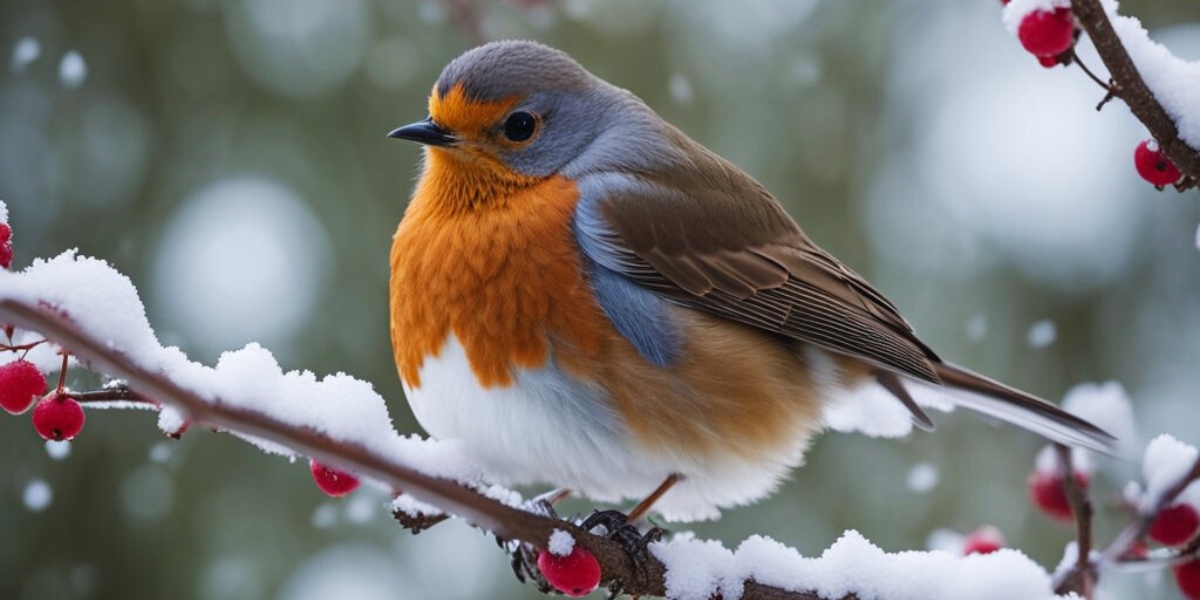As leaves start changing color in the fall, many bird species migrate south to warmer climates. However, not all birds participate in these massive seasonal movements. Some species tough it out through harsh northern winters as year-round residents. How do these non-migratory birds survive freezing temperatures, heavy snow, and scarce food? Let’s take a look at the hardy birds that stay put through winter and how they get by in challenging conditions.
What is Migration?
Bird migration refers to the seasonal travel of bird populations between breeding and wintering grounds. There are a few different types:
- Latitudinal – North-south migrations between temperate and tropical zones. Many songbirds undertake this migration.
- Elevational – Movement up and down mountains and highlands.
- Irruptive – Irregular migration triggered by food scarcity. See crossbills and snowy owls.
- Partial – Traveling only part of the migratory route. American Robins demonstrate this.
Birds migrate primarily to take advantage of abundant seasonal food sources, ideal breeding conditions, and favorable weather in different regions throughout the year.
What Birds Migrate?
There are several migratory groups:
- Neotropical migrants – Species that breed in temperate North America and winter in Central or South America like warblers, hummingbirds and orioles.
- Temperate migrants – Birds that migrate shorter distances within temperate zones such as American Robins and Red-winged Blackbirds.
- Irruptive migrants – Species like finches, crossbills, and owls that nomadically move based on food supplies.
What Birds Don’t Migrate?
While the majority of bird species migrate to some degree, these groups tend to stay put as year-round residents:
- Permanent residents – Birds that reside in the same region all year, without any seasonal movements.
- Short-distance migrants – Species like juncos and goldfinches that only migrate limited distances.
- Dispersive migrants – Birds like chickadees that disperse over a wide area instead of vacating territories.
Next, let’s take a closer look at some of the hardy bird species that tough it out through winter in northern latitudes year-round.
Year-Round Residents of Northern Climates
Some bird groups well-adapted to survive freezing winters as non-migratory residents include:
Chickadees
Black-capped, Carolina, and Boreal chickadees maintain territories year-round, roaming more widely in winter.
Nuthatches
Red-breasted, White-breasted and Pygmy nuthatches eke out insects and seeds from bark crevices.
Woodpeckers
Hairy, Downy, Pileated, and Red-bellied woodpeckers excavate for beetle larvae.
Corvids
Crows, ravens, jays, and magpies are highly adaptable and intelligent.
Owls
Great Horned, Snowy, and Northern Saw-whet owls hunt rodents and small birds.
They band together, excavate food, cache supplies, grow specialized feathers, and lower body temperatures to survive.
How Do Non-Migrating Birds Survive Winter?
Year-round birds have many adaptations and strategies for surviving harsh northern winters:
Adaptations
- Thick insulating down feathers to retain heat.
- High metabolic rates to generate energy.
- Feet with little surface area to prevent heat loss.
Winter Food Sources
- Cached seeds and nuts like acorns.
- Insects in bark crevices and galls.
- Winter berries and fruit.
- Small mammals and birds.
Shelter
- Tree cavities, nest boxes, and brush piles provide insulation.
- Roosting communally shares warmth.
Energy Conservation
- Regulating temperature by fluffing feathers.
- Lowering body temperature and entering torpor at night.
- Foraging only during warmest parts of day.
Challenges of Non-Migration
Despite their adaptations, non-migratory birds face many winter struggles:
- Thermoregulation – Maintaining adequate body heat with limited food takes considerable energy. Small birds like chickadees can die after just hours of cold exposure.
- Finding food – Most insects and fruits are not available. Competition spikes for limited winter food sources.
- Increased predation – Lack of foliage cover and desperate foraging exposes birds to more predators.
- Limited resources – Braving winter restricts birds to one locale with whatever habitat and food is available. Migrants can seek out optimal wintering grounds.
Benefits of Being Year-Round Residents
However, there are also advantages to toughing it out in one region instead of migrating:
- Territory maintenance – Staying on territories all year deters competing birds from claiming them.
- Mate retention – Remaining near mates improves bonding and increases reproductive success.
- Lower mortality – Skipping risky migrations reduces chances of starvation, predation, or collisions.
- Resource familiarity – Intimate knowledge of local food, water, and shelter locations helps ensure survival.
Next, let’s look at some specific examples of birds that remain as year-round residents.
Examples of Year-Round Residents
Some categories of birds that typically stay put throughout northern winters include:
Common Feeder Birds
Chickadees, titmice, nuthatches, jays, woodpeckers, and sparrows are feeder bird regulars year-round.
Raptors
Bald Eagles, Golden Eagles, owls, hawks, and falcons maintain territories as residents.
Hummingbirds
Anna’s and Rufous Hummingbirds increasingly overwinter in northern regions.
Waterfowl/Waterbirds
Mallards, gulls, grebes, loons, and mergansers endure winter at open waters.
Of course, there are many exceptions. Some juncos, robins, and red-winged blackbirds migrate while other populations remain as residents based on factors like available food. Additionally, more species like warblers and vireos are attempting to overwinter further north as climate change leads to warmer winters.
Should Birds That Struggle Wintering be Helped?
Some birds that try to overwinter at the extreme northern edges of their range stand little chance of surviving until spring. But should well-meaning people help struggling birds by providing food, shelter, and protection? Experts caution that helping birds too much can actually do more harm than good. However, there are a few beneficial things people can do:
- Providing emergency food/water – Short-term during extreme weather.
- Nest boxes and insulation – Helps insulation and warmth but must be predator-proof.
- Predator protection – Block access points to nest sites but don’t trap predators.
- Habitat management – Ensure adequate natural winter food sources and shelter exist through planting and protection.
However, the risks of feeding and closely interacting with birds often outweigh the benefits. Enjoy observing winter residents toughing it out naturally in your backyard.
How Climate Change Affects Year-Round Birds
A warming climate is altering migration patterns and greatly impacting northern birds that reside year-round:
- Warmer winters – Reduces energy needs for thermoregulation and makes overwintering easier.
- Shifting food sources – Alters plant fruiting times and reduces synchronized insect hatches that birds rely on.
- Increased competition – More short-distance migrants like robins overwintering, could compete for resources.
- More extreme weather – Intense cold snaps and big storms bring new challenges despite warmer overall trends.
It remains to be seen if the benefits of warmer winters outweigh the negatives of increased competition, extreme weather, and disrupted food availability. Careful monitoring will reveal climate change winners and losers.
People Also Read:
Conclusion
While the majority of bird species migrate to escape harsh northern winters, some hardy resident species have adapted to stick it out year-round. These non-migratory birds employ amazing strategies to survive frigid temperatures and scarce food through the winter. Backyard birders can support overwintering birds by providing emergency food and shelter during periods of extreme weather. However, residents have evolved to survive winter naturally, so our interference should be minimal. As climate change progresses, we will see northern wintering bird communities continue to shift in coming decades.

